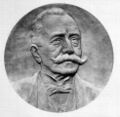Template:Selected anniversaries/March 6: Difference between revisions
Jump to navigation
Jump to search
No edit summary |
No edit summary |
||
| Line 1: | Line 1: | ||
<gallery> | <gallery> | ||
File:Henry Oldenburg.jpg|link=Henry Oldenburg (nonfiction)|1665: The first joint Secretary of the Royal Society, [[Henry Oldenburg (nonfiction)|Henry Oldenburg]], publishes the first issue of ''Philosophical Transactions of the Royal Society''. | File:Henry Oldenburg.jpg|link=Henry Oldenburg (nonfiction)|1665: The first joint Secretary of the Royal Society, [[Henry Oldenburg (nonfiction)|Henry Oldenburg]], publishes the first issue of ''Philosophical Transactions of the Royal Society''. | ||
File:The Governess.jpg|link=The Governess|1846: Social activist and alleged superhero [[The Governess]] warns the United States of America not to begin its upcoming Civil War ahead of schedule. | File:The Governess.jpg|link=The Governess|1846: Social activist and alleged superhero [[The Governess]] warns the United States of America not to begin its upcoming Civil War ahead of schedule. | ||
File:Cesare_Arzelà.jpg|link=Cesare Arzelà (nonfiction)|1847: Mathematician [[Cesare Arzelà (nonfiction)|Cesare Arzelà]] born. He will contribute to the theory of functions, notably his characterization of sequences of continuous functions. | File:Cesare_Arzelà.jpg|link=Cesare Arzelà (nonfiction)|1847: Mathematician [[Cesare Arzelà (nonfiction)|Cesare Arzelà]] born. He will contribute to the theory of functions, notably his characterization of sequences of continuous functions. | ||
File:Akiva Yaglom.jpg|link=Akiva Yaglom (nonfiction)|1921: Physicist, mathematician, statistician, and meteorologist [[Akiva Yaglom (nonfiction)|Akiva Yaglom]] born. He will contribute to statistical turbulence theory and random processes theory. | File:Akiva Yaglom.jpg|link=Akiva Yaglom (nonfiction)|1921: Physicist, mathematician, statistician, and meteorologist [[Akiva Yaglom (nonfiction)|Akiva Yaglom]] born. He will contribute to statistical turbulence theory and random processes theory. | ||
File:Carl Louis Ferdinand von Lindemann.jpg|link=Ferdinand von Lindemann (nonfiction)|1939: Mathematician and academic [[Ferdinand von Lindemann (nonfiction)|Ferdinand von Lindemann]] dies. He proved (1882) that π (pi) is a transcendental number. | File:Carl Louis Ferdinand von Lindemann.jpg|link=Ferdinand von Lindemann (nonfiction)|1939: Mathematician and academic [[Ferdinand von Lindemann (nonfiction)|Ferdinand von Lindemann]] dies. He proved (1882) that π (pi) is a transcendental number. | ||
File:Dawn spacecraft model.png|link=Dawn (spacecraft) (nonfiction)|2015: The ''[[Dawn (spacecraft) (nonfiction)|Dawn]]'' space probe, having left Vesta, enters Ceres' orbit. ''[[Dawn (spacecraft) (nonfiction)|Dawn]]'' will study Vesta and Ceres, two of the three known protoplanets of the asteroid belt. | File:Dawn spacecraft model.png|link=Dawn (spacecraft) (nonfiction)|2015: The ''[[Dawn (spacecraft) (nonfiction)|Dawn]]'' space probe, having left Vesta, enters Ceres' orbit. ''[[Dawn (spacecraft) (nonfiction)|Dawn]]'' will study Vesta and Ceres, two of the three known protoplanets of the asteroid belt. | ||
</gallery> | </gallery> | ||
Revision as of 06:12, 6 March 2022
1665: The first joint Secretary of the Royal Society, Henry Oldenburg, publishes the first issue of Philosophical Transactions of the Royal Society.
1846: Social activist and alleged superhero The Governess warns the United States of America not to begin its upcoming Civil War ahead of schedule.
1847: Mathematician Cesare Arzelà born. He will contribute to the theory of functions, notably his characterization of sequences of continuous functions.
1921: Physicist, mathematician, statistician, and meteorologist Akiva Yaglom born. He will contribute to statistical turbulence theory and random processes theory.
1939: Mathematician and academic Ferdinand von Lindemann dies. He proved (1882) that π (pi) is a transcendental number.




